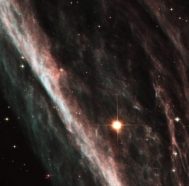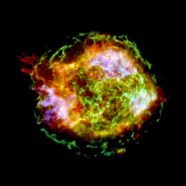A shock to the solar system
Scientists suspect a nearby exploding star ignited the formation of the sun and planets

No one was around when the solar system formed. Still, some scientists say it began with a blast. And they mean a big one: A nearby supernova, or explosion of a giant star, may have provided the oomph that jump-started the formation of the sun and planets.
Scientists suspect that more than 4.5 billion years ago, our swath of space had no sun, no asteroids, no planets, and no arguments about Pluto. Were you to go back in time, you’d instead find a large cloud of cold gas and dust. Obviously, it didn’t stay that way. Something happened, causing particles to clump together into one big star and lots of smaller rocks.
That something might have been a star that exploded about 15 light-years away. That’s the conclusion of astrophysicists with a new idea about how the solar system formed. Astrophysicists study stars and other objects in space to learn what they’re made of and how the bodies form. In this case, scientists used a computer program to test the idea that a nearby supernova triggered the cloud to turn into a star and planets.
Matthias Gritschneder is an astrophysicist at the University of California, Santa Cruz. He told Science News that the exploding-star idea provides a tidy solution to the mystery of the solar system’s origin. “With the supernova, you have one triggering event, and you don’t have to invoke a complicated chain of events,” he said.
A supernova sends a wave of energy, called a shock wave, racing through space faster than 6,000 miles per second. It sweeps up what’s left of the star’s mass and blows it away. This shock wave differs from a gently rolling water wave; it’s more like a tsunami, a giant wall of energy and matter that pummels anything in its way. In the computer program by Gritschneder’s team, the energy from a shock wave could have started collapsing the cold cloud of dust and gas.

Gritschneder isn’t the only one thinking about exploding stars. Astrophysicist Alan Boss works at the Carnegie Institution for Science in Washington, D.C. He also has shown how a supernova’s shock wave might have formed the solar system. He took a different approach than Gritschneder but reached the same conclusion.
“The basic results are the same for both of us, which is a relief,” Boss told Science News. On November 8, Boss talked about his work with other scientists at a meeting in Kauai, Hawaii.
Scientists gain confidence in radical ideas when different approaches produce the same answer. Fred Ciesla is an astrophysicist at the University of Chicago. He told Science News that even though many questions remain, the supernova idea is a good one. And it might help scientists understand how other worlds formed far beyond our solar system.
“Work like this says something about how stars and planets formed, and whether it’s consistent with the data we have,” Ciesla says. “Once we’ve been able to accumulate enough information, we can start to speculate about how frequently this works in other places in the galaxy.”
POWER WORDS (adapted from the New Oxford American Dictionary)
solar system The eight major planets and their moons in orbit around the sun, together with smaller bodies in the form of dwarf planets, asteroids, meteoroids and comets.
supernova A massive star that suddenly increases greatly in brightness because of a catastrophic explosion that ejects most of its mass.
galaxy A system of millions or billions of stars, together with gas and dust, held together by gravity.







